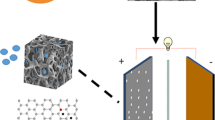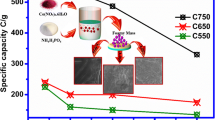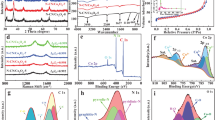Abstract
Red phosphorus (RP) is beneficial to industrialization due to its rich resources, chemical stability and environmental friendliness. However, the low electronic conductivity and large volume expansion limit its application for energy storage. Herein, we first used RP to prepare a novel bouquet-like Co3(HPO4)2(OH)2 by the hydrothermal approach as cathode materials for hybrid supercapacitors (HSC), which delivered a large specific capacity (119.2 mA h g−1 at 1 A g−1), a superb rate capability (83.6 mA h g−1 at 100 A g−1) and a splendid electrochemical stability (92% capacity retention after 5000 cycles at 10 A g−1). Furthermore, a novel HSC device assembled with Co3(HPO4)2(OH)2 as the cathode, porous carbon (PC) as the anode showed a high energy density of 44.6 W h kg−1 and a remarkable power density of 33.75 kW kg−1, along with an exceptional cyclic performance (91.8% capacity retention after 10,000 cycles at 3 A g−1). This study not only develops a novel type of high-performance battery-type cathode material, but also provides a new idea for the industrial application of RP.

摘要
红磷由于资源丰富、 化学稳定性好、 环境友好等优点有利于工业化. 然而, 低的电子导电性和大的体积膨胀限制了其在储能方面的应用. 本工作首次以红磷作为磷源, 利用一步水热法制备了一种新型的花束状Co3(HPO4)2(OH)2, 将其作为混合超级电容器的正极材料时展现出大的比容量(在1 A g−1时的比容量为119.2 mA h g−1)、 极好的倍率性能(在100 A g−1时的比容量为83.6 mA h g−1)和出色的电化学稳定性(在10 A g−1下5000次循环后的容量保持率为92%). 此外, 以Co3(HPO4)2-(OH)2作为正极和多孔碳作为负极组装出的新型混合超级电容器表现出高达44.6 W h kg−1的能量密度和高达33.75 kW kg−1的功率密度, 以及出色的循环性能(在3 A g−1下10,000次循环后的容量保持率为91.8%). 该研究不仅开发了一种新型高性能的电池型正极材料, 而且为红磷在储能领域的商业化应用提供了新的思路.
Similar content being viewed by others
References
Simon P, Gogotsi Y, Dunn B. Where do batteries end and supercapacitors begin? Science, 2014, 343: 1210–1211
Chen J, Lee PS. Electrochemical supercapacitors: from mechanism understanding to multifunctional applications. Adv Energy Mater, 2021, 11: 2003311
Yun X, Lu T, Zhou R, et al. Heterostructured NiSe2/CoSe2 hollow microspheres as battery-type cathode for hybrid supercapacitors: Electrochemical kinetics and energy storage mechanism. Chem Eng J, 2021, 426: 131328
Gui Q, Ba D, Li L, et al. Recent advances in materials and device technologies for aqueous hybrid supercapacitors. Sci China Mater, 2022, 65: 10–31
Tang H, Yao J, Zhu Y. Recent developments and future prospects for zinc-ion hybrid capacitors: A review. Adv Energy Mater, 2021, 11: 2003994
Li X, Elshahawy AM, Guan C, et al. Metal phosphides and phosphates-based electrodes for electrochemical supercapacitors. Small, 2017, 13: 1701530
Zhou J, Shi Q, Ullah S, et al. Phosphorus-based composites as anode materials for advanced alkali metal ion batteries. Adv Funct Mater, 2020, 30: 2004648
Han X, Han J, Liu C, et al. Promise and challenge of phosphorus in science, technology, and application. Adv Funct Mater, 2018, 28: 1803471
Chen X, Xu G, Ren X, et al. A black/red phosphorus hybrid as an electrode material for high-performance Li-ion batteries and supercapacitors. J Mater Chem A, 2017, 5: 6581–6588
Zhu J, Liu Z, Wang W, et al. Green, template-less synthesis of honeycomb-like porous micron-sized red phosphorus for high-performance lithium storage. ACS Nano, 2021, 15: 1880–1892
Zhang Y, Sun L, Bai L, et al. N-doped-carbon coated Ni2P-Ni sheets anchored on graphene with superior energy storage behavior. Nano Res, 2019, 12: 607–618
Dan H, Tao K, Zhou Q, et al. Ni-doped cobalt phosphite, Co11(HPO3)8-(OH)6, with different morphologies grown on Ni foam hydro(solvo) thermally for high-performance supercapacitor. ACS Appl Mater Interfaces, 2018, 10: 31340–31354
Huang J, Xiong Y, Peng Z, et al. A general electrodeposition strategy for fabricating ultrathin nickel cobalt phosphate nanosheets with ultrahigh capacity and rate performance. ACS Nano, 2020, 14: 14201–14211
Zhu Y, Lu P, Li F, et al. Metal-rich porous copper cobalt phosphide nanoplates as a high-rate and stable battery-type cathode material for battery-supercapacitor hybrid devices. ACS Appl Energy Mater, 2021, 4: 3962–3974
Liang Z, Qu C, Zhou W, et al. Synergistic effect of Co-Ni hybrid phosphide nanocages for ultrahigh capacity fast energy storage. Adv Sci, 2019, 6: 1802005
Zhang T, Mao Z, Shi X, et al. Tissue-derived carbon microbelt paper: A high-initial-coulombic-efficiency and low-discharge-platform K+-storage anode for 4.5 V hybrid capacitors. Energy Environ Sci, 2022, doi: https://doi.org/10.1039/D1EE03214C
Aldama I, Barranco V, Ibañez J, et al. A procedure for evaluating the capacity associated with battery-type electrode and supercapacitor-type one in composite electrodes. J Electrochem Soc, 2018, 165: A4034–A4040
Zhou K, Zhou W, Yang L, et al. Ultrahigh-performance pseudocapacitor electrodes based on transition metal phosphide nanosheets array via phosphorization: A general and effective approach. Adv Funct Mater, 2015, 25: 7530–7538
Song W, Wu J, Wang G, et al. Rich-mixed-valence NixCo3−xPy porous nanowires interwelded junction-free 3D network architectures for ultrahigh areal energy density supercapacitors. Adv Funct Mater, 2018, 28: 1804620
Surendran S, Shanmugapriya S, Sivanantham A, et al. Electrospun carbon nanofibers encapsulated with NiCoP: A multifunctional electrode for supercapattery and oxygen reduction, oxygen evolution, and hydrogen evolution reactions. Adv Energy Mater, 2018, 8: 1800555
Chen HC, Jiang S, Xu B, et al. Sea-urchin-like nickel-cobalt phosphide/phosphate composites as advanced battery materials for hybrid supercapacitors. J Mater Chem A, 2019, 7: 6241–6249
Jing C, Guo X, Xia L, et al. Morphologically confined hybridization of tiny CoNi2S4 nanosheets into S, P co-doped graphene leading to enhanced pseudocapacitance and rate capability. Chem Eng J, 2020, 379: 122305
Lin Y, Sun K, Liu S, et al. Construction of CoP/NiCoP nanotadpoles heterojunction interface for wide pH hydrogen evolution electrocatalysis and supercapacitor. Adv Energy Mater, 2019, 9: 1901213
Tang T, Cui S, Chen W, et al. Bio-inspired nano-engineering of an ultrahigh loading 3D hierarchical Ni@NiCo2S4/Ni3S2 electrode for high energy density supercapacitors. Nanoscale, 2019, 11: 1728–1736
Zhu Y, Li J, Yun X, et al. Graphitic carbon quantum dots modified nickel cobalt sulfide as cathode materials for alkaline aqueous batteries. Nano-Micro Lett, 2020, 12: 16
Elshahawy AM, Guan C, Li X, et al. Sulfur-doped cobalt phosphide nanotube arrays for highly stable hybrid supercapacitor. Nano Energy, 2017, 39: 162–171
Liu Q, Hong X, You X, et al. Designing heterostructured metal sulfide core-shell nanoneedle films as battery-type electrodes for hybrid supercapacitors. Energy Storage Mater, 2020, 24: 541–549
Ramachandran R, Lan Y, Xu ZX, et al. Construction of NiCo-layered double hydroxide microspheres from Ni-MOFs for high-performance asymmetric supercapacitors. ACS Appl Energy Mater, 2020, 3: 6633–6643
Hu X, Nan H, Liu M, et al. Battery-like MnCo2O4 electrode materials combined with active carbon for hybrid supercapacitors. Electrochim Acta, 2019, 306: 599–609
Sheng L, Chang J, Jiang L, et al. Multilayer-folded graphene ribbon film with ultrahigh areal capacitance and high rate performance for compressible supercapacitors. Adv Funct Mater, 2018, 28: 1800597
Zhao R, Di H, Wang C, et al. Encapsulating ultrafine Sb nanoparticles in Na+ pre-intercalated 3D porous Ti3C2Tx MXene nanostructures for enhanced potassium storage performance. ACS Nano, 2020, 14: 13938–13951
Liu J, Wang J, Xu C, et al. Advanced energy storage devices: Basic principles, analytical methods, and rational materials design. Adv Sci, 2018, 5: 1700322
Lan Y, Zhao H, Zong Y, et al. Phosphorization boosts the capacitance of mixed metal nanosheet arrays for high performance supercapacitor electrodes. Nanoscale, 2018, 10: 11775–11781
Li J, Yun X, Hu Z, et al. Three-dimensional nitrogen and phosphorus co-doped carbon quantum dots/reduced graphene oxide composite aerogels with a hierarchical porous structure as superior electrode materials for supercapacitors. J Mater Chem A, 2019, 7: 26311–26325
Sankar KV, Lee SC, Seo Y, et al. Binder-free cobalt phosphate one-dimensional nanograsses as ultrahigh-performance cathode material for hybrid supercapacitor applications. J Power Sources, 2018, 373: 211–219
Mirghni AA, Momodu D, Oyedotun KO, et al. Electrochemical analysis of Co3(PO4)2·4H2O/graphene foam composite for enhanced capacity and long cycle life hybrid asymmetric capacitors. Electrochim Acta, 2018, 283: 374–384
Pang H, Yan Z, Wang W, et al. Facile fabrication of NH4CoPO4·H2O nano/microstructures and their primarily application as electrochemical supercapacitor. Nanoscale, 2012, 4: 5946
Cheng M, Fan H, Xu Y, et al. Hollow Co2P nanoflowers assembled from nanorods for ultralong cycle-life supercapacitors. Nanoscale, 2017, 9: 14162–14171
Chen X, Cheng M, Chen D, et al. Shape-controlled synthesis of Co2P nanostructures and their application in supercapacitors. ACS Appl Mater Interfaces, 2016, 8: 3892–3900
Shao H, Padmanathan N, McNulty D, et al. Supercapattery based on binder-free Co3(PO4)2·8H2O multilayer nano/microflakes on nickel foam. ACS Appl Mater Interfaces, 2016, 8: 28592–28598
Acknowledgements
The work was financially supported by the National Natural Science Foundation of China (21601057) and Hunan Provincial Natural Science Foundation (2021JJ30216).
Author information
Authors and Affiliations
Contributions
Author contributions Lu P designed and performed the experiments, and wrote the paper with support from Zhu Y. All authors contributed to the general discussion.
Corresponding author
Ethics declarations
Conflict of interest The authors declare that they have no conflict of interest.
Additional information
Supplementary information Experimental details and supporting data are available in the online version of the paper.
Pengcheng Lu received his BS degree in 2019 from Hunan University of Technology, China. Currently, he is pursuing his MS degree at the College of Materials and Advanced Manufacturing, Hunan University of Technology. His present research focuses on phosphorus-based electrode materials for hybrid supercapacitor devices.
Yirong Zhu is an associate professor of the College of Materials and Advanced Manufacturing at Hunan University of Technology, China. He earned his MS degree in 2008 from Central South University. After that he worked as a senior engineer at Zhuzhou Hongda Electronics Co., Ltd (2008–2012). Then, he received his PhD degree in 2015 from Central South University, and engaged in postdoctoral research at Central South University (2016–2019). Currently, his research interests mainly focus on the design and development of advanced electrode materials for supercapacitors.
Supporting Information
40843_2021_1936_MOESM1_ESM.pdf
Novel bouquet-like cobalt phosphate as an ultrahigh-rate and durable battery-type cathode material for hybrid supercapacitors
Rights and permissions
About this article
Cite this article
Lu, P., Chen, Y., Zhou, R. et al. Novel bouquet-like cobalt phosphate as an ultrahigh-rate and durable battery-type cathode material for hybrid supercapacitors. Sci. China Mater. 65, 1503–1511 (2022). https://doi.org/10.1007/s40843-021-1936-0
Received:
Accepted:
Published:
Issue Date:
DOI: https://doi.org/10.1007/s40843-021-1936-0




